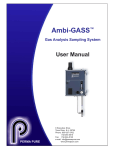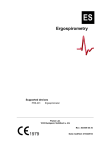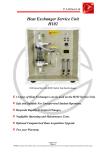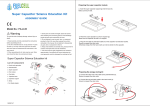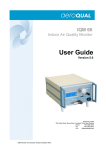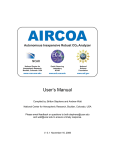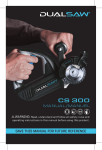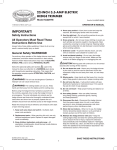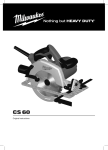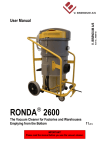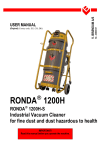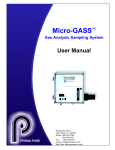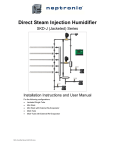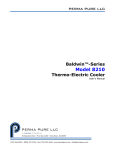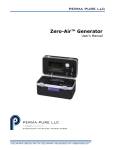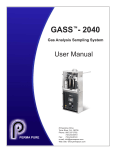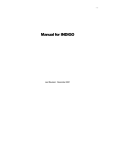Download GASS Module™ - Perma Pure LLC
Transcript
GASS Module™ Gas Analysis Sampling System User Manual PERMA PURE 8 Executive Drive Toms River, N.J. 08755 Phone: 800-337-3762 732-244-0010 Fax: 732-244-8140 e-mail: [email protected] Web Site: www.permapure.com GASS Module User Manual TABLE OF CONTENTS 1. Introduction..................................................................................................4 2. GASS Module Component...........................................................................5 2.1 Filter 2.2 Automatic Filter Drain (optional) 2.3 Filter Thermocouple (optional) 2.4 Purge Eductor (optional) 2.5 Nafion Dryer 3. Installation...................................................................................................8 3.1 Mounting 3.2 Electrical Connection A. Filter Section 1. Filter Heater 2. Filter Heater Thermocouple (Optional) 3. Automatic Drain (Optional) B. Dryer Section 1. Dryer Heater 2. Dryer Heater Thermocouple C. Ground Wire Connection 3.3 Plumbing A. Sample Connection B. Purge Inlet Connection C. Purge Exhaust/filter Drain Connection D. Purge Eductor Inlet Connection 4. Start-Up Procedure.....................................................................................11 4.1 Setup Check 4.2 Purge Air Flow Adjustment 4.3 Preheating the System 5. Maintenance...............................................................................................12 5.1 Filter 5.2 Dryer Appendix A - Specifications.....................................................................................14 Appendix B - PD Dryer Element Replacement........................................................15 Bulletin #217 2 GASS Module User Manual WARNING Thank you for purchasing sample gas conditioning equipment from Perma Pure LLC. We want your new sample gas conditioning equipment to operate safely. Anyone who installs or uses this equipment should read this publication before installing or operating this equipment. To minimize the risk of potential safety problems, you should follow all applicable local and national codes that regulate the installation and operation of your equipment. These codes vary from area to area and usually change with time. It is your responsibility to determine which codes should be followed and to verify the equipment, installation and operation is in compliance with the latest revision of these codes. At a minimum, you should follow all applicable sections of the National Fire Code, National Electrical Code, and the codes of the National Electrical Manufacturer’s Association (NEMA). There may be local regulatory or government offices that can also help determine which codes and standards are necessary for safe installation and operation. Equipment damage or serious personal injury can result from the failure to follow all applicable codes and standards. We do not guarantee the products described in this publication are suitable for your particular application, nor do we assume any responsibility for your system design, installation or operation. This product should not be operated in any manner that is inconsistent with its intended use. If you have any questions concerning the installation or operation of this equipment, or you need additional information, please call us at 1-800-337-3762. TRADEMARKS This publication is based on information that was available at the time it was printed. At Perma Pure we constantly strive to improve our products and services, so we reserve the right to make changes to the products and/or publications at any time without notice and without any obligation. This publication may also discuss features that may not be available in certain revisions of the product. Trademarks Nafion® and Teflon® are registered trademarks of EI DuPont de Nemours Copyright 1996-2005, Perma Pure LLC. All Rights Reserved. Bulletin #217 3 GASS Module User Manual 1. Introduction Perma Pure GASS Module™ sample conditioning systems are designed to prepare gas samples for analysis. The GASS Module system will remove, particulates, mists and water vapor without removing compounds being monitored. A heated sample line is connected to the top fitting on the GASS Module (see Figure 1). Sample gas flows to the filter where particulates are removed and/or mists are coalesced. After filtration, sample is passed through the Nafion® Dryer where water vapor is selectively removed. Sample is now ready for analysis. Standard Features Include: • Filter - Particulate and/or Coalescing • Perma Pure Nafion® Gas Dryer • Purge Eductor • Filter Thermostat • Dryer Heater Thermocouple • Module Housing • Mounting Clamps Options: • Automatic Filter Drain • Filter Heater Thermocouple and Extension Wire Figure 1 Bulletin #217 4 GASS Module User Manual 2. GASS Module Components Filter: First step in conditioning the sample is to filter out particulates and aerosols by passing it through a 1µ filter consisting of a borosilicate glass filter element with a fluorocarbon binder. The element is disposable and will withstand high sample temperatures. Automatic Filter Drain (optional) If coalescing is anticipated, the system should be fitted with an automatic filter drain to periodically remove collected liquid mists (in most cases it is acid mist). The automatic drain will operate in a vacuum or pressurized system. 1. Vacuum Configuration Collected liquid is withdrawn from the filter drain port by a strong vacuum. The vacuum is created by an eductor expanding compressed air through a venturi which should be controlled in cycles by an adjustable digital timer (provided by customer). The timer switches a solenoid valve and controls compressed air supply. 2. Pressurized Application An eductor is not required since a vacuum is not needed to withdraw the sample. Therefore, the condensate withdraw is directly controlled by the solenoid valve. Cycle times can be varied and will be dependent on the amount of liquid present in the sample. Filter Thermocouple (optional) The filter heater comes standard with a thermostat wired in and preset at 90°C but if sample condensate is anticipated, an additional temperature controller should be used in place of the thermostat to control the heater at a lower temperature. Purge Eductor (optional) Eductor generates a vacuum to draw condensate from the filter and to drop pressure of the purge gas to prevent collapsing of Nafion tubing. Nafion Dryer The Perma Pure Nafion membrane dryer is installed downstream of the filter. As sample enters the dryer, the flow splits into a number of small diameter Nafion membrane tubes which are arranged in a parallel bundle as shown in the figure below. The shell and multitube moisture exchangers transfer water vapor between two countercurrent flowing gas streams as seen in the drawing below. Dry purge gas flowing over the exterior surface of the Nafion tubing continuously extracts water vapor from the gas stream inside the tubing. The driving force is the difference in water concentration on the opposite sides of the tubing wall. The purge gas then carries the water vapor away. Dry purge gas enters the dryer at the sample outlet end and performs two functions: 1. Provides a medium for the water vapor from the sample to be carried away. 2. Creates the temperature gradient along the length of the dryer. Bulletin #217 5 GASS Module User Manual Ambient purge air enters the dryer at the sample outlet keeping that portion of the dryer cooled. This counter current flow is required to produce a temperature gradient along the length of the dryer. To effectively maintain the gradient, the temperature of the purge gas exhaust must be monitored and controlled by an electronic temperature controller (customer provided). As purge gas passes through the dryer, it is heated to desired sample inlet set point temperature. This gradient allows for both rapid vapor removal and decreased final dew point. If purge gas temperature begins to fall below the set point, module’s heaters will adjust to maintain the set point. The aluminum housing will conduct energy from the heaters to the dryer’s shell tube. Purge gas traveling through the dryer’s shell, acquires heat from the shell. This process allows final temperature of the purge gas to be closely controlled and a consistent temperature gradient will be maintained. It is important that the dryer removes water in vapor state only to avoid problems that arise when the membrane comes in contact with liquid water. If liquid water is introduced into the dryer, efficiency will decline and the dryer could fail to perform altogether. Tubing elongates approximately 10% over its dry length when saturated with liquid water causing tubing to kink inside the dryer housing, reducing drying. Nafion dryers will operate most efficiently when a portion of the dryer is heated to prevent sample from condensing out liquid water. Bulletin #217 6 GASS Module User Manual 3 Installation (see Figure 2 for reference.) 3.1 Mounting Unit should be shielded from direct rain and snow. Do not install outdoors if temperature will fall below -10°C. 1. Module must be arranged on vertical surface with filter section on top and dryer sample outlet/purge inlet on bottom. 2. Remove mounting clamps from GASS Module. 3. Mount to rigid surface through mounting slots (spaced 2 5/8" apart). 4. Place GASS Module into clamps and secure. 3.2 Electrical Connections GASS Module is equipped with two separate heater assemblies. One heater is located on top portion (filter section) and other heater is placed on bottom portion (dryer section). Both heaters require an AC power source. A. Filter Section Filter Heater Connection 1. Locate 5 pole connector (labeled “Filter Heater Connection”). These wires are connected to a thermostat in filter section that is pre-set to 90°C. 2. Connect heater wires to 115 VAC or 230 VAC power source (see Figure 3). 110 VAC 220 VAC Figure 3 Bulletin #217 8 GASS Module User Manual Filter Heater Thermocouple Connection (Optional) If sample condensate is expected, an automatic drain assembly is used, a second therm couple is mounted on the filter section. This thermocouple must be wired to an additional temperature controller provided by customer. 1. Locate thermocouple mounted through outer insulation on filter section (labeled “Filter Heater Thermocouple”). 2. Connect Type J thermocouple extension wire from connector provided to an additional temperature controller. This controller will be used to control filter heater’s power instead of internal pre-set thermostat. Automatic Filter Drain Valve Connection (Optional) Optional solenoid valve can be connected to filter section if automatic draining of sample condensate is desired. 1. Locate Automatic Filter Drain Valve two pole connection. 2. Connect to customer’s control system. B. Dryer Section WARNING! DO NOT connect directly to AC power. Doing so will cause permanent damage to Nafion dryer. Dryer Heater Connection 1. Locate 3 pole connector (labeled “Dryer Heater”). 2. Connect wires to customer supplied PID type temperature controller. Dryer Heater Thermocouple Connection 1. Locate thermocouple mounted in tee fitting of purge outlet port (labeled “Dryer Thermocouple Type J”). 2. Connect Type J thermocouple extension wire provided to customer supplied temperature controller to control dryer heater power. C. Ground Wire Connection Bulletin #217 1. Locate green wire separate from any other wiring harnesses. 2. This is the grounding wire for the GASS Module. 3. Connect grounding wire to appropriate earth ground. 9 GASS Module User Manual 3.3 Plumbing A. Sample Connection 1. With unit securely mounted, connect sample line directly to ¼” or 3/8" compression fitting on top of module. The 3/4” SS nipple sample inlet connection can be used to attach customer supplied conduit fitting for rigid connection to heated sample line (see Figure 4). If it is not being used,ensure it is well insulated to prevent cold spots which causes sample condensation. 2. Connect ¼” NPT sample outlet port of GASS Module to sample line running to analyzer. Figure 4 B. Purge Inlet Connection Purge gas must be of instrument grade with a dew point no higher than–40OC. 1. Purge gas should be supplied to dryer via 0-30 slpm flowmeter and a regulator capable of supplying 0-50 psig. Refer to flow schematic for proper setup. 2. Connect regulated purge gas supply line to 1/8" female NPT purge inlet port of membrane dryer (labeled “Instrument Air”). C. Purge Exhaust/Filter Drain Connection With optional automatic filter drain – With auto drain option, purge gas exhaust is combined with the filter drain. Therefore, exhaust may contain acid condensate when drain valve is energized. Connect line from eductor outlet to designated collection/exhaust basin containing acid absorption media to prevent release of exhaust to surrounding. Line should not restrict purge flow. A ¼” I.D. tubing can be used for runs up to 10 feet, or larger I.D. tubing for longer exhaust lines. Without optional automatic filter drain – Purge exhaust may contain water vapor. A line can be connected from purge outlet to remote area if desired. Line should not restrict purge flow. A 1/4" I.D. tubing can be used for runs up to 10 feet, or larger I.D. tubing for longer exhaust lines. D. Purge Eductor Inlet Connection Connect compressed air supply line to nozzle of eductor inlet via regulator capable of supplying 0-50 psig. Bulletin #217 10 GASS Module User Manual 4 Start-Up Procedure 4.1 Setup Check 1. Check electrical, sample, purge, and drain connections have been made and set temperature controller(s) to desired setpoint(s). 2. Turn on instrument and/or compressed air to system. 4.2 Purge Air Flow Adjustment 1. To achieve correct vacuum of 5” Hg to drain acid condensate from filter, set purge air eductor pressure to 25 psig. 2. Adjust purge air flow to 20 l/min before applying power to temperature controller. 3. Check purge air is exhausting from system. 4.3 Preheating the System 1. Turn on AC power to system. WARNING! DO NOT BEGIN SAMPLE FLOW AT THIS TIME! If, for any reason, there is no purge air or flow is inadequate, turn off AC power before attempting to locate problem. Operating system with little or no purge air can cause permanent damage to membrane dryer assembly. Bulletin #217 2. Recheck purge air is exhausting from system. 3. Set temperature controller of dryer heater 5-10°C above expected sample dewpoint temperature. 4. Do not flow sample until dryer temperature has come up to desired setpoint. 5. If temperature controller is utilized to control filter heater, set it’s temperature slightly above expected sample dewpoint temperature. 6. Wait for filter to come to set temperature. 7. At this point, sample flow may be started. 11 GASS Module User Manual 5 Maintenance 5.1 Filter The system is fitted with a coalescing filter element which should be checked regularly to ensure that element is in good condition. If element appears to be dirty or begins to cause flow restriction in system, it should be replaced. Filter Element Replacement: 1. For ease of filter replacement, GASS Module should remain mounted. 2. Stop sample flow. 3. Disconnect sample inlet line from top of module (see Figure 5). 4. Hold module cap with one hand and pull ring on cap with other hand. 5. While pulling ring out, rock cap and pull upward to release o-ring seal in filter housing. 6. Remove filter element from inside housing. 7. Position new element on filter/module cap by centering element on cap assembly. 8. Apply thin layer of silicone-based lubricant on o-ring of filter cap. 9. Carefully insert filter element (while on cap assembly) back inside filter housing. 10. Reattach module cap. 11. Ensure o-ring on filter cap is properly seated to prevent sample gas from leaking. 12. Reconnect sample line to inlet of GASS Module. 5.2 Dryer Dryer element replacement: Tools Needed: - Allen wrench - Snap ring pliers - Pair of lightweight gloves 1. 2. 3. 4. 5. 6. Bulletin #217 Follow Steps 1-6 for filter element replacement. Disconnect all wiring. Remove assembly out of mounting clamps. Remove Eductor and Drain (if optioned). Remove Dryer Assembly from housing. Follow PD dryer element replacement in Appendix B. 12 GASS Module User Manual Filter Element Shims Dryer Housing Module Housing Bottom End Nut Dryer Housing Module Cap Ring End Nut & Filter Housing Eductor Mounting Clamps Figure 5 Bulletin #217 13 GASS Module User Manual APPENDIX A - Specifications MAXIMUM SAMPLE FLOW RATE: 0 TO 10 LITERS/MIN MAXIMUM INLET SAMPLE TEMPERATURE: 275°F MAXIMUM GAS SAMPLE WATER VAPOR CONTENT: 30% OUTLET SAMPLE DEW POINT: (With PD-200T-24" dryer) (With PD-100T-24" dryer) (With PD-50T-24" dryer) 26°F (-4°C) at 10 L/MIN 12°F (-12°C) at 5 L/MIN -12°F (-25°C) at 2 L/MIN 36°F (2°C) at 10 L/MIN 26°F (-4°C) at 5 L/MIN 6°F (-15°C) at 2 L/MIN 42°F(5°C) at 10 L/MIN 34°F(1°C) at 5 L/MIN 22°F(-6°C) at 2 L/MIN SOLUBLE GAS REMOVAL RATES: NO, NO2 SO2 CO, CO2 H2S, HCl MAXIMUM GAS SAMPLE INLET PRESSURE: 10 PSIG MINIMUM GAS SAMPLE INLET PRESSURE: 10" H2O VACUUM WITHOUT EDUCTOR OPTION GAS SAMPLE INLET FITTINGS: 1/4" or 3/8" TUBING FITTINGS GAS SAMPLE OUTLET FITTINGS: 1/4" NPT AIR REQUIREMENTS: PURGE AIR -40°C DEW POINT MAXIMUM ONE (1) CFM ELECTRICAL REQUIREMENTS: CUSTOMER SUPPLIED FUSE 110/220VAC, 50/60 Hz OPERATING ENVIRONMENT: -20°C TO 40°C AMBIENT TEMP 0 TO 95% R.H. Bulletin #217 0% loss 0% loss 0% loss 0% loss 14 GASS Module User Manual APPENDIX B - PD DRYER ELEMENT REPLACEMENT PD WITH TWO PART END FITTINGS TO DISASSEMBLE DRYER (see PD drawing below) Tools Needed: -Allen wrench 3/32 -Snap ring plier -Pair of lightweight gloves 1. 2. 3. 4. 5. 6. 7. 8. Hold coupling and shell with one hand, and remove front nut on each end with the other. Loosen set screws on both ends of couplings using Allen wrench. Remove snap ring from both sides using snap ring pliers. Put on pair of lightweight gloves(protects membrane tubing from skin oils contaminating surface and reducing drying efficiency). Pull element header out of housing on one side to expose o-ring. Do not rotate more than 10° in either direction. Remove inner o-ring. Gently pull element out other end. Reverse procedure to assemble dryer. Two Part End Fitting PD Dryer Bulletin #217 15 GASS Module User Manual PD WITH ONE PART MOLDED FITTINGS TO DISASSEMBLE DRYER (see Molded PD Dryer Drawing below) Tools Needed: - Phillips head screwdriver - unsharpened pencil with eraser 1. 2. 3. 4. 5. 6. 7. Loosen locking screws on both ends of dryer. Insert eraser end of pencil into one sample port until it rests on tube header face(see Figure on right). Hold dryer vertically and place other end of pencil down onto a hard, slip resistant surface. While supporting shell tube of dryer, push lower end fitting down with consistent pressure until it slips off shell tube. Do not attempt to pull fitting from shell tube; doing this is likely to damage dryer element tubing. Repeat steps 2-4 for other end. Remove one o-ring from tube header. Pull tube element from opposite end of dryer. Tube Header TO ASSEMBLE DRYER Tool Needed: - Phillips head screwdriver 1. 2. 3. 4. 5. 6. 7. 8. Bulletin #217 Install one thick o-ring onto grooved tube header. Slip opposite tube header into dryer shell. Install other thick o-ring onto groove. Push one thin o-ring into groove inside coupling (for SS and AL shells slip o-ring on shell across two holes). Firmly push coupling over tube header. Align purge port with hole in shell tube(see Figure on right). Tighten locking screws until underside of screw head contacts top of boss. Repeat steps 4-7 for opposite end. Check for Alignment Sample Port 16

















